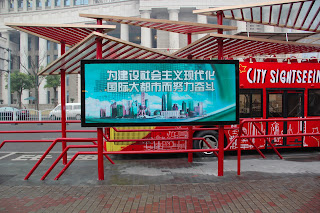Woods around Lingyin Temple. Greenery still visible beneath the snow. (photo cred: Frank)
A small pagoda in the park surrounding Lingyin Temple. Snow was picturesque.
Lingyin Temple (photo cred: Frank)
Frank with Mr. Snowman (Someone had built him in Lingyin Temple)
The Bund -- it'll make you think you're not in China
The dirty Huangpu River
Shanghai's Pudong District during a rainy/smoggy day
Puding District (photo cred: Frank)
Shanghai's famous Shengjian Buns (生煎包) filled with meat and broth.
Government propaganda. A literal translation: "Struggle hard to create a socialist, modern, international metropolitan city"
In the very touristy Yu Gardens (豫园)
Shopping building in Yu Gardens
Can't escape the realm of Starbucks
Citibank building reads "I heart Shanghai"
Obligatory photo of the Shanghai night skyline
The Bund at night
Bored on the subway (photo cred: Frank)
Leifeng Pagoda in Hangzhou
View looking from Leifeng Pagoda to the outdoor escalator below
View from the top of Leifeng Pagoda overlooking West Lake and the Hangzhou "skyline"
Waiting for dumplings at a hole-in-the-wall place in Hangzhou (photo cred: Frank)
Still waiting.
Chill puppy in the McDonald's at Hangzhou Airport
In order to keep things in chronological order, this post will be reversing back to early January, when Frank and I took a brief trip down to Hangzhou and Shanghai. I chose Hangzhou because I had heard it was a generally pleasant city with milder winters than Beijing. Unfortunately for us, it snowed in Hangzhou the day before our arrival (which I later learned is extremely rare), so we got to slosh around in wet snow for a couple days.
Hangzhou has a few well-known places to see including Leifeng Pagoda (雷峰塔), West Lake (西湖), and Lingyin Temple (灵隐寺). We visited Lingyin Temple on our first day in Hangzhou. It is Hangzhou's most famous Buddhist temple, built in the fourth century A.D. Because it had just snowed, the temple appeared especially serene (see pictures). On the second day of our trip we took a high-speed train into Shanghai (78 RMB, 55 minutes). My first impression of Shanghai back in 2008 was not a particularly good one, but this time around I enjoyed it substantially more. Most notably, the taxi drivers seemed friendlier and their Mandarin more understandable (probably a combination of chance and the fact my own Mandarin has improved since then). In addition, this time I noticed how much more of a city-feel Shanghai has than Beijing. This is possibly because it has the Huangpu river (黄浦江) running through it, the Bund (外滩), and the modern Pudong district (浦东区), which provides Shanghai with its iconic skyline. Nevertheless, Shanghai was disappointingly polluted, and not just the air. The Huangpu river looked absolutely horrendous (see photo). This is the same river that supplies Shanghai with all of its drinking water, and the same river where over 3000 pig carcasses were found in the past two weeks.
Anyway, my favorite part of the trip to Shanghai was the Shanghai Propaganda Art Center (shanghaipropagandaart.com), which is run by an older Chinese fellow (with surprisingly good English) in the basement of a completely low-profile apartment building a fair distance west of the Bund. It houses original propaganda posters from the 20th century, especially after 1949. Many praise Maoism, Leninism, and Marxism while condemning the U.S. and Japan. There are also original and replica pieces for sale. While the originals are a tad expensive, I would deem them absolutely worth it.
Back in Hangzhou, we visited Leifeng Pagoda, which looks out over the entirety of West Lake and the Hangzhou "skyline." (Like most Chinese cities, it doesn't really have a skyline in the American sense. See photos to see what I mean.) Finally, while waiting for our return flight back to Beijing in the new and modern Hangzhou airport, we spotted a hilarious little dog in dog-clothing chilling on the top of his owner's suitcase trolley in McDonald's.
My lasting impression of Hangzhou is that it is a wealthy, relatively developed and pleasant southern city. Like almost all southern cities in China, it had much more greenery and felt less polluted than Beijing, which was also nice.




























